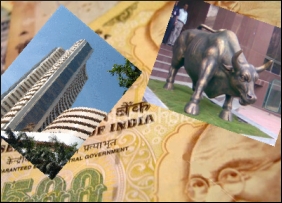|

|
India's Sensex ends 2008 with 52-pc annualized loss
|
|

|
|
| Top Stories |
 |
|
|
|
James Jose - Yearender | 02 Jan, 2009
The dramatic start for Indian equities market in 2008, which saw a key index scale an all-time high, ended in a whimper, with the global economic meltdown pulling the bellwether down by 52 percent - its worst ever performance.
As trading drew to a close on Wednesday, the 30-share sensitive index (Sensex) of the Bombay Stock Exchange (BSE) ended at 9,647.31 points, down 10,639.68 points, or 52.45 percent, over the previous year's close at 20,286.99 points.
The Sensex, thus, was the third worst performer among emerging economies, after Shenzen and Shanghai indices of China, analysts said.
This was in sharp contrast to 2007 when the Mumbai bourse was the third best performer among emerging economies, after the Weighted Taipei of Taiwan and Jakarta Composite of Indonesia, with a gain of 47.15 percent.
"For most of 2008, our markets were volatile, taking negative cues from global markets. We suffered, as we are now very much a part of the global economy,” Neera Jain, chief technical analyst with a stock-market portal CRN India, told IANS.
During the first two weeks of this year, the markets were on a roll, sending the 30-share Sensex to its all time high, intra-day high of 21,206.77 points on Jan 10.
Then came "Black Monday" of Jan 21, when the index shed nearly 2,000 points intra-day, but managed to close with a loss of 1,392.30 points, or 7.32 percent - which was still one of the steepest falls ever.
Then started a prolonged period of volatility, which eventually sent the Sensex to its 52-week, intra-day low of 7,697.39 points on Oct 27.
The loss for mid-cap index of the exchange was higher at 66.95 percent for the year, while that for small-cap index was even steeper at 72.41 percent.
Among the 13 sector-specific indices, that for realty fell the most, down 82.13 percent, while metals followed with a loss of 73.95 points, consumer durables, down 72.49 percent and capital goods, down 65.02 percent.
Among the remaining, the index for fast-moving consumer goods, down just 14.33 percent, healthcare, down 32.87 percent, public enterprises, down 49.56 percent, technology, down 51.51 percent, and banking, down 52.23 percent, logged losses that was lower than that for the Sensex.
Foreign funds, which were like adrenalin for the bulls till 2007, also started selling rather heavily to cover the huge losses they had incurred in other markets, notably in the US.
For the first time in a decade, they were net sellers to the tune of $13.135 billion during 2008, as per statistics available with the markets watchdog, Securities and Exchange Board of India (SEBI).
Their net investment in the country's equities market stood at $53.194 billion at as on Dec 31, against $66.329 billion as on the like date of last year.
"September and October saw foreign funds sell ruthlessly, irrespective of the stock, scrip price or the sector," said Jagannadham Thunuguntla, head of the capital markets arm with SMC Group.
"This happened because their parent entities faced margin pressure calls."
But the year did no pass by without its share of high-points.
The Anil Ambani-led Reliance Power Ltd came out with an initial public offering (IPO) in January, which was oversubscribed 73 times and garnered an astronomical $190 billion.
"It is the largest subscription of any IPO anywhere in the history of global capital markets, with a record five million applicants," a beaming Ambani told at a press conference, a day after the issue's conclusion.
But thereafter, the appetite for public issues was rather low.
"An extremely bearish and nervous secondary market through the year saw 2008 with a very low mobilisation," said Prithvi Haldea, chairman and managing director of Prime, a New Delhi-based database.
"Only Rs.16,927 crore (Rs.169.27 billion) was raised by way of public issues - a fall of 63 percent on Rs.42,137 crore (Rs.421.37 billion) in 2007," Haldea said, adding, Reliance Power alone accounted for 60 percent of the money raised.
Looking ahead, analysts maintained that much depended on the developments in the global economy, notably in the US, since foreign funds were expected to continue playing a major role in the Indian markets.
"I expect the dust to settle down post January," said Vijay Chopra, national head for business alliances with Unicon Investment Solutions, an investment advisory and brokerage.
"The results of measures taken by the government will start showing. The coming year also holds some more good news like the Barack Obama administration assuming office in the US and offering more help to the ailing US economy."
|
|
|
| |
|
|
|
|
|
|
|
|
|
|
|
|
|
|
| |
| Customs Exchange Rates |
| Currency |
Import |
Export |
US Dollar
|
84.35
|
82.60 |
UK Pound
|
106.35
|
102.90 |
Euro
|
92.50
|
89.35 |
| Japanese
Yen |
55.05 |
53.40 |
| As on 12 Oct, 2024 |
|
|
| Daily Poll |
 |
 |
| Do you think Indian businesses will be negatively affected by Trump's America First Policy? |
|
|
|
|
|
| Commented Stories |
 |
|
|
|
|
|
| |
|